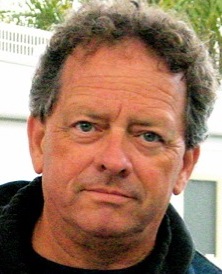The Windhook Interview—Susannah Ward
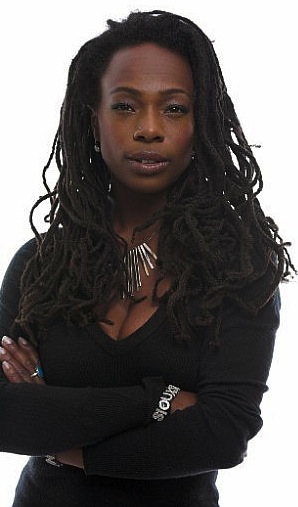
Susannah Ward is an artist, writer, and art model from Ottawa, Canada. In this fun and fascinating interview we explore Susannah's art, and the notion of art modeling as a supplemental income source for artists. Susannah paints and writes several blogs, including one specifically for art models, Diaries of an Art Model. She also has a beautiful website to market her modeling career, and has opened us up to a further exploration in future issues of the ins and outs, challenges and opportunities that face artists' models. You will see more down the line from Susannah in Outside the Lines.
Michael: Susannah, we know you mostly through our contact at Art Model Place [link is broken at the time of this posting], and we know you as an art model, but we'd kind of like to know a little of your art and your background—where you came from, how you got where you are.
Susannah: OK, My father is the fine artist in the family. I come from a family of ten kids. I started my art training at the Ottawa School of Art, (OSA) which is a centre for visual arts education and creative expression here in the nation's capitol. I took the Portfolio Development course, a diploma program, in 2000, which prepares a student's portfolio if they want to pursue a fine arts degree at the university level, or if they want to go into interior design, photography, architecture or what have you. The school is constantly looking for models and for the newer models they have a one-day workshop that teaches participants how to figure model. I went to this art school as an artist myself, for portfolio development, and to broaden my understandings about the fine arts. That's how I was able to catch onto the model program. Growing up I was always a painter, singer, dancer—I've displayed all of those creative abilities but I think out of all the kids in the family I'm the only one who has taken serious steps towards making it a full time career.
Peggy: As a child you drew and painted and all of that?
Susannah: We had very active imaginations as little kids. I remember we used to have entertainment night once a week, and all of us had to display our talents. We make a guitar out of cardboard, and play a Queen song to entertain my dad and step-mom, or I was Michael Jackson and my sister was Paul McCartney, and she'd play on the piano and we'd do our little duet. Yeah, we were very creative kids.
|
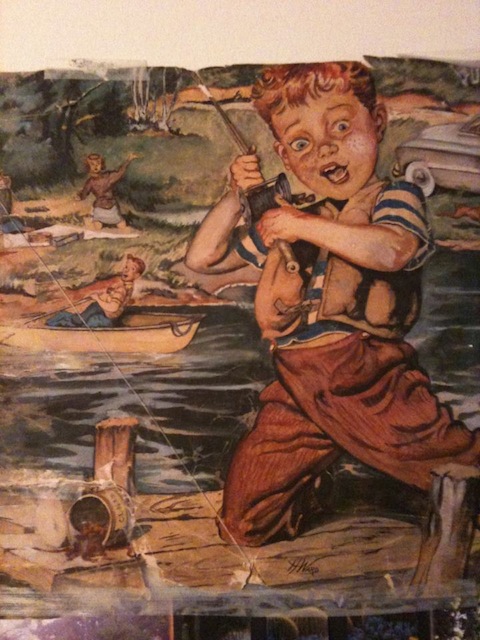
Image by Harold Ward
|
Michael: And your dad is an artist.
Susannah: Yes. He is an artist but he hasn't been doing that for a long time. I believe he holds a fine arts degree. Instead, he became a high school teacher for about 23 years and then began teaching at McGill University, Metallurgical Engineering and head of the Science lab. He's retired now. Who knows? Maybe he'll go back to it.
Michael: So he didn't teach art?
Susannah: No he taught mathematics, actually. Mathematics and mechanics, I think. But he's a mathematician by trade. His fine arts is really strong but he said he finally had to stop it because he started our family and art doesn't pay the bills.
Michael: This is a challenge a lot of people face, and a lot of people don't really find a good way to solve it. So I understand that.
|
|
Peggy: Was your mother an artist as well?
Susannah: No, she wasn't.
Peggy: And she had ten kids.
Susannah: No she had seven. She passed away when I was eight months old. She was a primary school teacher, and she was more into keeping the family and family business in line. I don't know much about her background in art, if she had any, but I do know that she was not the artist in the family.
Peggy: Are you the youngest?
Susannah: Yes, of the first set of seven. My dad remarried and there were three more sisters, who in turn got my father's talent.
Peggy: Ok, I see.
|
|
Michael: Talk to us a little bit about your art. Tell us what you do.
Susannah: My art is really a way of self expression. It's about me articulating things I haven't found words to express. I work through three parallels right now, and I don't know if it's the wisest thing to do. When working on three concepts at the same time it's hard to put enough time and energy and resources into one thing. People say to focus on one talent, and once you get that down, go on to the other ones. But I tend to move them along at the same time. They're symbiotic.
|

Image by Susannah Ward
|
|
The sunflower work is about spirit; it connects to my childlike, naive, playful character, and sunflowers go back to my kindergarten days, and a place of joy for me. When I look at the sunflower, its characteristics embody the human spirit. It has a strong tall stalk, like your confidence and your inner core. It's always following the sun, generating energy. It's a rugged flower but if your ego gets too big it droops— like the head of a sunflower that's full of seeds. The cycle of the sunflower's life is about three months, from germination, growth bloom to harvest. If you are making a transition to a new thing in life, you can use the sunflower as a symbol, a mantra, a mandala, to help you understand that there is a cycle to everything, whether it's moving to a new home, getting a new job, starting a new relationship, or having a baby. There's a cycle. This is what I demonstrate with my artwork.
I'd often go into medical journals to get anatomical images of the heart or other organs to put into the disk of the flower, or abstract the flower in some way to give it an organic feel and to bring it back to the human spirit. I have a saying, "Plant a seed, say a prayer, and watch your blessings grow."
|
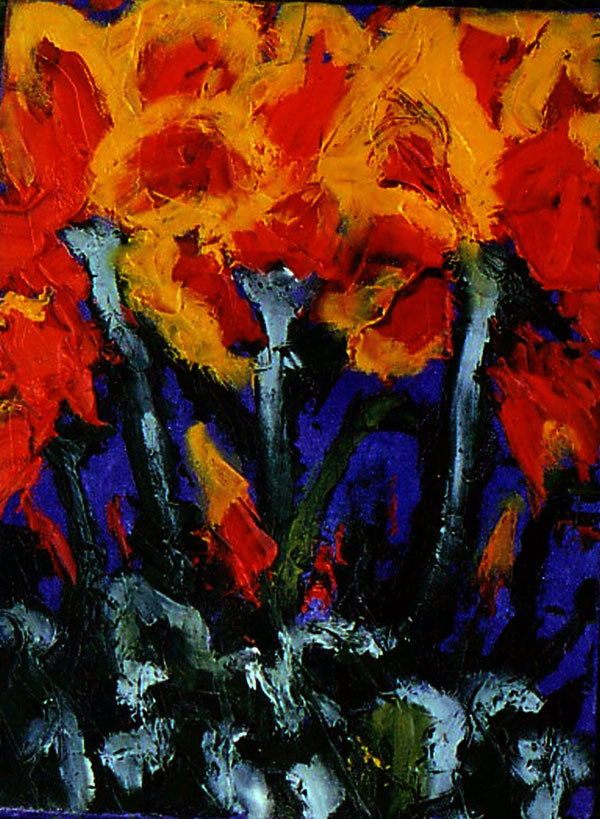
Image by Susannah Ward
|
Peggy: I saw that on your web site. Very nice.
Michael: You said there were three branches to your creative work.
Susannah: Yes, the second is my writing. The writing is more the mature side and engages the intellect—the mind. The writing stems from the fact that I am trying to articulate that we are growing a new kind of human beings. A new way of seeing and understanding things. We are at a paradigm shift with our society, and with my writings I'm trying to articulate that in my own mind and throw it out into the world. You know, I was brought up quite religiously, and I kind of dumped that. I went through a series of six friends dying, all of them within about six months or a year. One of them was a very strong archetypical relationship that spanned about eleven years. That really hit close to home and it made me start questioning everything—coming to terms with my mother's passing, religion, feminism, humanism, politics, everything. I wasn't really prepared for the type of regeneration I went through. It was a spiritual regeneration. That's how the sunflowers and then the writing starts to form that synergy.
|
|
Michael: I can really relate to writing as a cathartic process for working through these things. I've done a lot of that myself.
Peggy: When I was looking through your writings on the web I thought, "Oh, she's Anglican but Michael was raised Southern Baptist," I thought the parallels are there, and the writing and the process of turning to art, and..."
Susannah: I'm going to take it a little further. I was actually Jehovah's Witness.
The story you are referring to is Hanging with a Bishop.
I was just taking minutes at an Anglican synod thinking it was an annual general meeting, or so I was told when I got the job. But it ended up being an Anglican synod. When I was there "hanging" with the bishop, at lunch he was surprised to learn that the minute taker's roots stemmed from Jehovah's Witness.
Peggy: Oh my. I didn't get to read that part. I'll have to go back to that.
Susannah: I hid it. It's only in one sentence, so it's ok if you missed it. Out of respect for the religion, I try not to advertise that part of myself – I don't think the Jehovah's Witnesses would like me to advertise that, but then again – there's Michael Jackson – enough said. But I'm sure there are some similarities you can see.
|
|
Peggy: Sunflowers, writing, and the third one?
Susannah: The third would be the modeling itself. Modeling is about the body and having body confidence; accepting phytsically who you are, and your core that radiates outwardly. Even though the external side of me is the way that it looks, I really didn't like myself and I didn't really see a good reflection back when I looked in the mirror. My hair was really short and straight like Halle Berry, and I used to wear colored contacts, which really added a dimension to my black skin and to my look. So I would wear purple contacts, green contacts, blue contacts, and all the hair products, the jell, and all that was in there, and I looked good, with the sexy outfits and everything. Then I became friends with a Rastafarian, and he always encouraged me to grow dreadlocks. I was turning a new leaf at the time, so I finally said OK. It's an interesting transformation that happens when one goes from processed hair to a natural look.
|
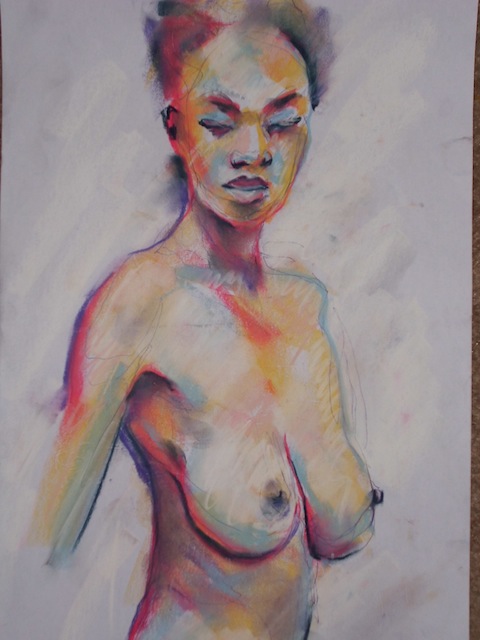
Image by Dan Northcotte
|
|
I naturally have Afro hair, so all the corrosive products that I had to straighten my hair were quite expensive. The first change I noticed was that the expense to look beautiful was gone. I never wore the contacts anymore, and I never even wore makeup. When you go dreadlock it makes you go back to your natural beauty. It makes you go inward to find where your beauty resides and then it radiates out—like the sunflower.
Michael: Well, of course!
|
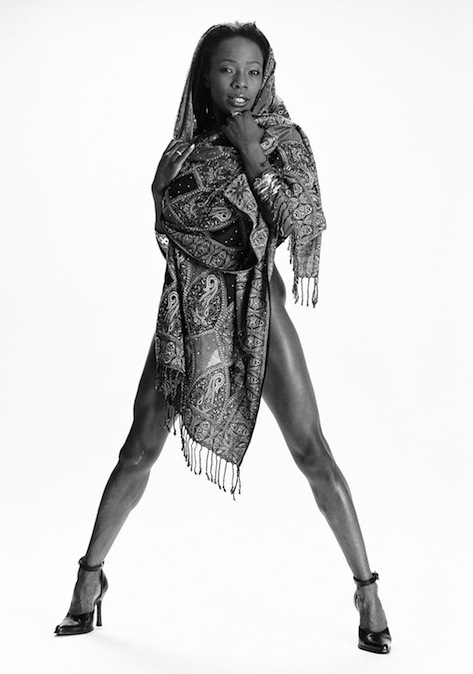
Image by Menno Spjiker
|
Susannah: You go through an ugly duckling stage where you look like Buckwheat from the Little Rascals. You know, it looked like little worms were sticking out all over my head. And as it grew a little longer, my inner core became stronger—like Samson and Delilah. Merging the concept of inner strength and beauty with the length of the hair, and then Delilah, you know, she's just a beautiful woman, and you're trying to bring her back out. It got to a point where I started feeling comfortable with who I was, but I didn't know how to reintegrate the sexiness that I had before with this newfound external identity. My brother is a photographer, and he encouraged me to do modeling. Mind you, he didn't think I was going nude. [Laughter]
But there was no other way. I approach my modeling as a form of art. And to go into ads for different products felt a little too commercialized. That's not where I wanted to go. I wanted to express inner beauty with my work in modeling.
|
|
So I prefer modeling for fine arts over modeling for glamor photography. But I do both, with the exception in photogrtaphy that I stay in the fine arts and artistic categories. When you do art modeling, you do get to see what the other artists are seeing. I try not to look behind the easel because they often feel uncomfortable. It's a work in progress. But there are a lot of times I do get to see what they're doing. And it's interesting to see how they interpret your beauty. Even with photographers it's interesting to see the images, because I get to see what their experiences and perceptions of me are.
|
|
A lot of girls want to explore their sexuality or show their sexiness, and they often end up maybe dancing at a titty bar or going to clubs and all that stuff. But I didn't feel that I wanted to trade my sense of moral values—by saying that I don't want to condemn those that do, we choose paths that seem right to us at the time and it's a personal choice. And for me, I didn't want to regret what I was doing down the road, and with what I do right now I can hold my head up high. I used to work in conservative environments, and they knew exactly what I was doing. They were like, "Rock on!" Because they saw the art, and the intent. It exudes that I'm here for the artistic side rather than showing off my itsy-bitsy parts. My lips are not pouting and I don't have bedroom eyes, or the suggestive poses. I don't do any of those photo shots. I have very strong parameters around that and you get to see it in my work.
Michael: Yes. I have read quite a few things written by models on Art Model Place and a few of the other modeling websites, and it seems very common for art models to see it as a creative expression. It's a theme that seems to run throughout the industry.
|
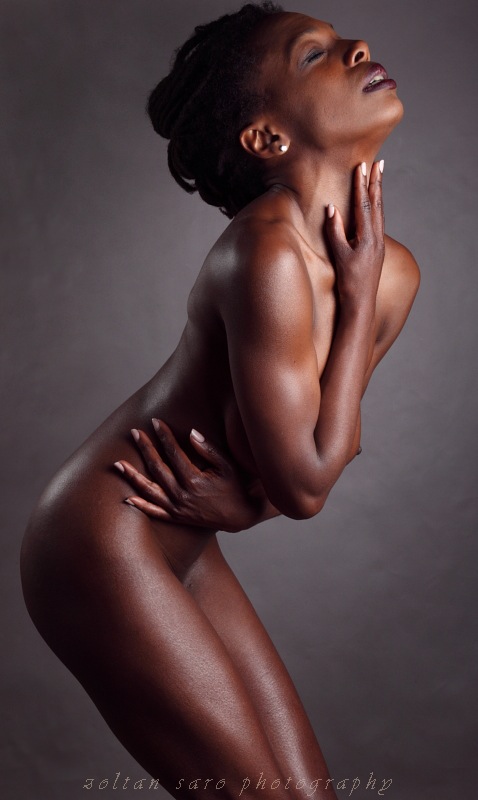
Image by Zoltan Saro
|
|
Susannah: It is. But there are many girls I have met along the way who started off in the fine art category but saw that it didn't really make them enough money, so they expanded their portfolio to include other categories. There's fine arts, and then there is artistic, and then erotic, and then you go into pornography, and there is a whole richter scale of it all. The art stuff is the fun stuff and the other stuff, which which can be more dangerous, is what can really pay the bills because they pay a lot more for a photo or video shoot. So I'm always trying to make people understand that there are different levels of nude modeling, and to be clear about what levels they are comfortable with. But with art and art photography modeling, it's always good, but it doesn't always pay so well.
Michael: Exactly.
|
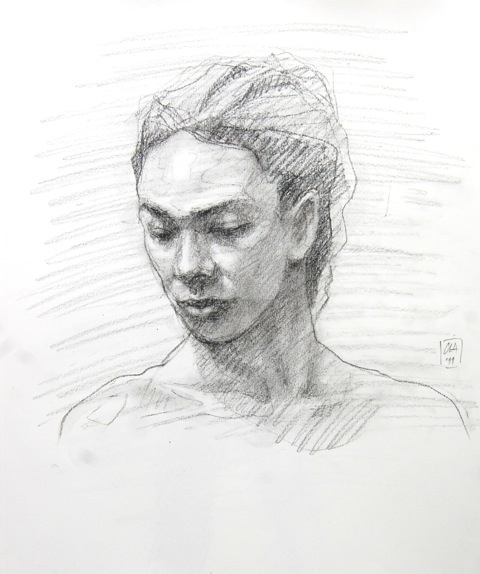
Image by Charlene Lau Ahier
|
Susannah: So the way I work it is that the art modeling with schools and organizations pays less, yet they are more frequent. It can be the bread and butter for an art model. Art photography brings better pay but is less frequent, especially with the economy today. My clients aren't advertisers or agencies. My clients are the artists themselves. So I find that when I am dealing with a painter or sculptor or a fine art school, they will never haggle you over the price. They have a set price and they say this is what our price is and this is what we give to our models. But at least they don't try and haggle you for a TFP shoot. Photographers sometimes pit you against other models who would give their time for free.
In the fine arts genre, they'll always respect the craft you are in and they'll always pay.
Michael: Explain to our readers what TFP means.
|
|
Susannah: Time for prints. Or TFCD which is time for CD. Time for prints is basically when you get these photographs back for what you do.
Michael: And that's your pay.
Susannah: And that's your pay. Especially for somebody like myself, who travels across the border a lot for assignments, I pay for my own airfare, accommodations and incidentals—so TFP isn't always the best route to go for models because we do have our own expenses to think of. Photographers usually say, it's the client that pays not us. But even a stipend of $50 or $100 is better than nothing.
|
|
I have a very good roster of fine art work. I still do the photography. But sometimes you don't even get the prints back. From the photographer's point of view, he or she may have many shoots on the go, and then there's all this post production and editing they have to do, and have to go through hundreds (even thousands) of images, so they get inundated, and some models end up falling through the cracks. You don't always get the work back or it takes an extremely long time to get your images back or you don't get the expected quality of work back. So I've learned to be a little more cautious in my dealings in the industry of photography.
For TFP shoots a model may be interested in engaging in such an agreement because it's free professional style photos to 'beef-up' their portfolio. And because I don't deal in the commercial side of modeling these types of shoots don't always work for me because I don't do commercial work. Instead, I like to try to share rights or get permission to use the images to try to earn back what I've spent to show up for the shoot and my time.
|
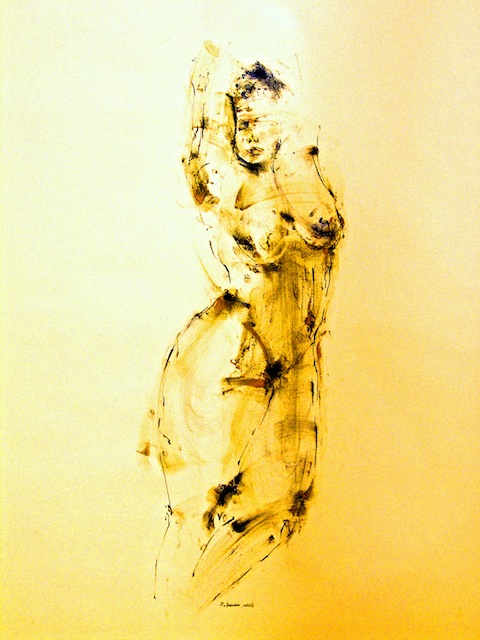
Image by Larry Dedioniso
|
|
And with these images I hope to do things like make my own calendar series, or my own gift cards, or fine art poster prints. So with some photographers we tend to engage in those kinds of conversations and agreements. Some photographers, however, shy away. Some don't like dealing with a smart model. They become quite territorial about their images, and rightly so, therefore you've got to pick and choose the photographers to work with. If they're open to some sort of sharing copyright of images, in lieu of payment, that works. They do the processing, and their name goes on it because that's their work. They give me the final print and I can market it, handle the administration and fulfillment of orders, which is an investment in itself. In the end it's a benefit to the photographer, because they get credit and I am promoting their work and extending their visibility in the marketplace. If they think along those lines it works but sometimes they clam up about copyright and licensing, and all that stuff.
|
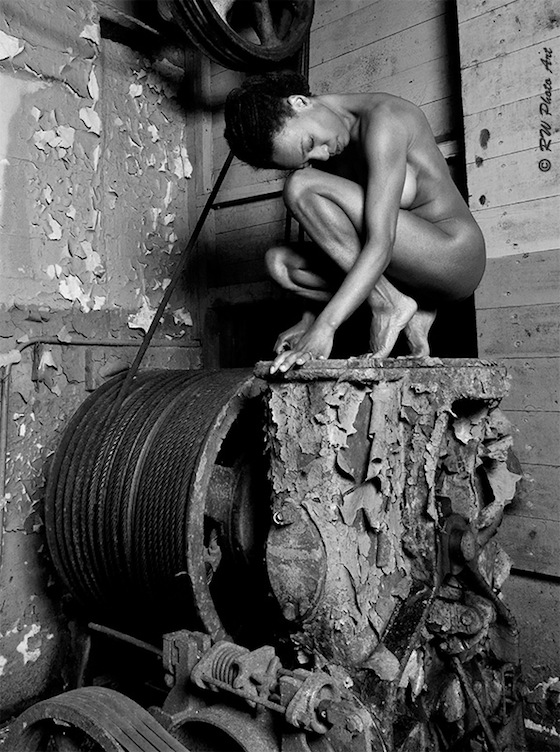
Image by Roy Whidoon
|
Michael: Your blog about urban decay caught my interest. I've followed an artist named Miru Kim. She's based in New York City. She's from Korea. She's traveled all over the world, sneaking into forbidden and abandoned places that are locked and hidden away and you're not supposed to go there—she's been in catacombs in Europe, and in abandoned and condemned places all over the world. She sneaks into these places and sets up a camera then climbs up into these places nude, and takes pictures of herself in the context of these places. She did a really interesting TED talk about this. I think I actually posted a link to that TED talk on your Urban Decay blog entry.
Peggy: Are you still doing the administrative work? Is the fine art modeling covering your bills now?
Susannah: It used to, but the economy has been poor and when you have a poor economy the creative industry is the first to suffer because its considered as non-essential services. When I was starting off the modeling career, I employed the services of a temp agency, and when you are working for a temporary agency, you sign a contract for a week, or three months, or whatever, and you work and save a little bit, then you can take off when it's done.
|
|
So the temporary service industry was good for me to give me the necessary funds to pay my rent, and to save for a traveling gig and go off for two months. I guess a waitress/bartender job would work too, but working in the office environment has also helped me with business of my art. You're in all these different offices, learning all these different business skills that you need as a business person. I find a lot of people are so caught up when they're starting their art business with what they are trying to sell that they don't realize that you have to wear all these different hats. You're the accountant. You're the mail person. You're HR. You're the advertiser. So by being able to work in the temporary services industry, I was able to grab the tools I needed to work my business of art. Whether it was typing a memo, creating my web site, dealing with taxes, learning to use Quickbooks. All these things helped me to learn to navigate the business side of my art.
In a full time job they don't want you taking off like that, and you have limited vacation. So a full time job is not always the best when you do what I do. There's travel, and the shoots are at all different hours of the day.
|
|
I recently stopped working a full-time 9-5 job at a consulting firm. I tried to get flex time because with that I would be able to telecommute. Basically, what I did for them is edit/proofread documents. I don't need to be in the office to do that as long as there is a computer to work on.
But since that option is not open to me I decided to take the summer to focus more on the marketing/selling of my art prints, work on my sunflowers and my writings. This fall I'm preparing to go to university for my bachelor of humanities. I need the summer to hyper-focus on developing my newer body of artistic works because once school starts I'll be fully entrenched in my studies and will have limited time for my artistic pursuits until the summer break. But I could allocate time to market the body of work I've developed over these summer months.
|
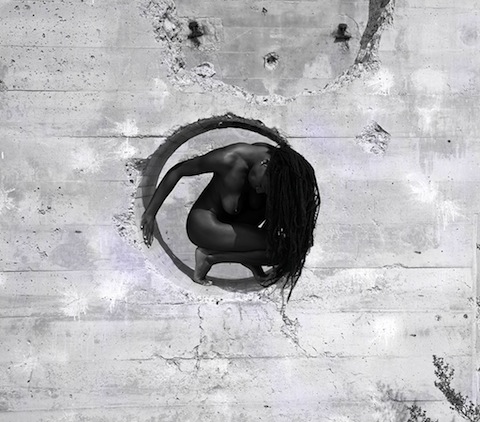
Image by Rich Tosti
|
|
Peggy: We know somebody who actually runs a business called "Virtual Assistant." She has people who have a variety of technical and administrative and graphic skills and when somebody needs someone with those skills she brokers that. Everybody works from their home and is independent.
Susannah: Everybody seems to be going that route. Starting a business, or being self employed is a big thing right now, because there is very little to no job security. If you're starting your own business, you don't have the funds to employ a secretary the full 40 hours a week, so those part-time services really do help. I haven't had a chance to hook up with somebody in the industry to offer my services as a transcriber. Maybe that's something I should explore, and thank you for that.
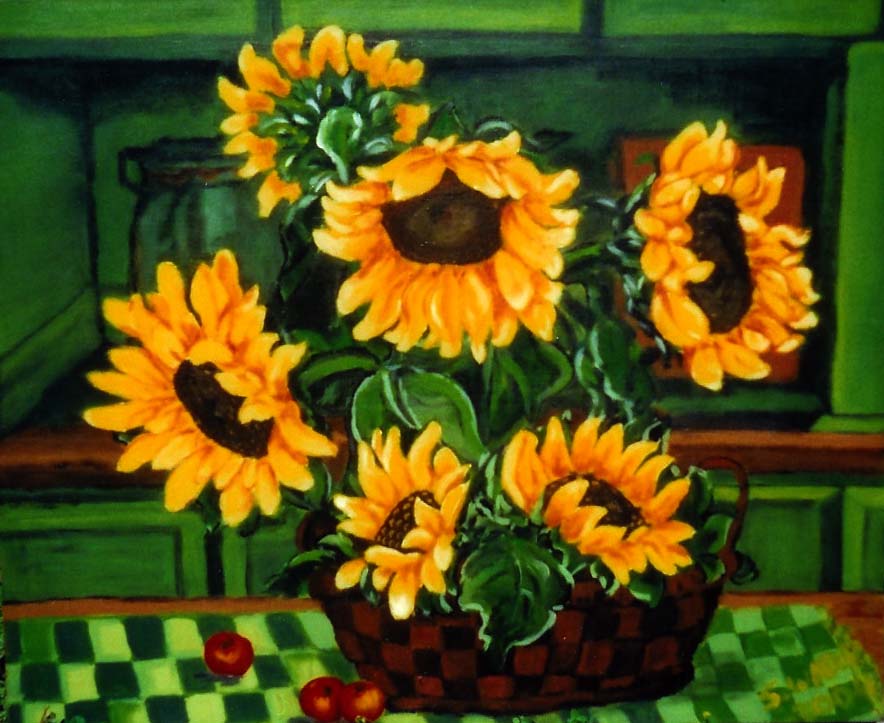
Image by Susannah Ward
Peggy: I'll send you the link. The other thing I did notice is that on the sunflower web site you said something about a new branch of sales.
Susannah: Yes. With my Sunflower work I'm starting to get into bath and body care, and that's what I hope to be my bread and butter, rather than doing the 9 to 5. I'm working on my new body of work, and hope to have it ready by August. And my paintings become the illustrations for the packaging on my labels.
Peggy: Very nice.
Susannah: So people will get used to seeing my artwork when they are buying their lotions or soaps. It's a whole concept that's based on my creativity. When you buy my products, you're actually buying my artwork too. I'm integrating my artwork into the products that I sell.
|

Image by Susannah Ward
|
Peggy: I love that image of the woman. Was it you? The smiling woman in the middle of the sunflower?
Susannah: Yes, that's me. I body painted myself as a sunflower, found a sunflower patch and had photographs taken and used it as a basis for the painting.
Peggy: I love that.
Susannah: Thank you!
Peggy: It has that whole sunny happy thing going. I can see where that would fit with your products. The other interesting thing when I was scrolling through and looking at your various web sites—It has struck me over and over again with the folks we have interviewed—the intensity of the passion and the constant creativity. Always thinking of new things to do. New ways to express yourself. It's really wonderful. You always have so many irons in the fire, but you have so much energy about all of them.
|
|
Susannah: It's in your DNA. I can't stop it. I haven't really tried to. It's who I am. A way of being. A way of living. But I find the same thing talking to my peer group. They say the same thing. It's just a way of thinking. It's very different from somebody who lives on the right side of the brain. Every time I take a rest and try to focus on the 9 to 5, I get irritable. I get angry, and short tempered, because I know I'm not doing what I should be doing. I wish there was a way where we could focus on our work and not have to balance it with the 9 to 5. But people still see art as fun. They don't see it as a viable business path. Maybe that tension is part of the creative process.

Michael: Let's go back to modeling for a little bit. My experience with models is that I'll show up for a group session related to an art group. For instance there might be a weekly session, and there will be different models that come and sit for two or three hours maybe in several different poses, or one long pose. Maybe artists who use models a lot have a sense of this, but I think a lot of people really wouldn't know what that's all about from a model's perspective. Describe a modeling session for us. By the way, you have some really interesting pieces in your art modeling blog about this. I was quite fascinated with the ones about Focus, and the green tape.
Susannah: That was a very interesting exercise because I didn't even realize that was a problem, finding your focus, and especially if you're in a portrait class and all they're looking at is your face. So if you get all shifty-eyed and freaky, that is a problem. And then once you get that focal point it's very important to hold the gaze. I didn't realize that because I naturally just find my focal point. That was the first instance where I found myself litterally staring at a blank wall. And if you can't find a focal point on a blank wall, your eyes go everywhere trying to find a focus, just like a camera.
Michael: You have mentioned yoga and martial arts as good skills too. Learning to manage and relax your body while controlling it.
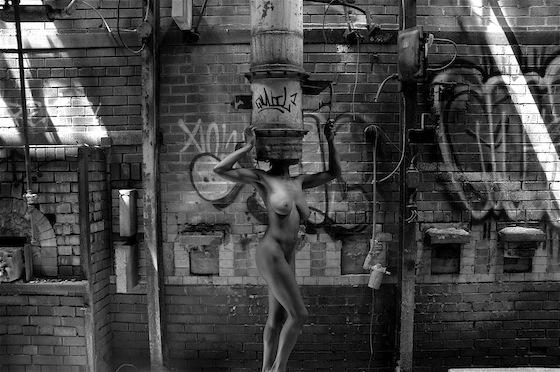
Image by Robert Cheshire
Susannah: Yoga poses or ballet really help. It's all about posture. If you have good posture, it makes you a good model. Whether it's yoga, tai chi, or ballet, those things help you to have a good inner core and help you keep your posture. That's what artists really look for—and to be able to hold a pose. And then on those long poses, when a session is over and you break out of a difficult pose incorrectly, you could ruin your body. You've got to know how to get into and out of the pose properly. That's where the yoga and tai chi and ballet kind of helps. Transitions and holding a pose, and understanding what your body is telling you. Maybe you've got too much weight in one area. How do you shift your weight without ruining the pose, but giving your body the relief it needs when you feel your muscles tingle or shake. Shifting your weight in such a slight way that the artists don't even know it but it gives some sort of relief to you. And you know, ballet is big on that.
Michael: Yes, I took a semester of ballet in college. I didn't accomplish anything really, except to learn how hard it is. But the one thing I did learn from that, and from the little yoga I have done, is that these things are about learning how to relax with control.
Susannah: Exactly.
Michael: Typically, if you haven't practiced those kinds of disciplines, when you relax you just sort of go limp. But that's really not what this is. Relaxing with control is a very different thing. And it would seem absolutely essential if you are going to hold a pose for more than a minute.
The other thing I'd like to talk about, and you touched on this earlier, is that in addition to the physical and presentation aspects of this, there's also an emotional aspect to modeling. Not everybody is going to be able or willing to put themselves into a position to do nude modeling. Some people will be just too uncomfortable with the very thought of exposing themselves that way. It seems to me that for people that do this, there almost has to be a spiritual development aspect to getting yourself to a place where you can comfortably do this.
|
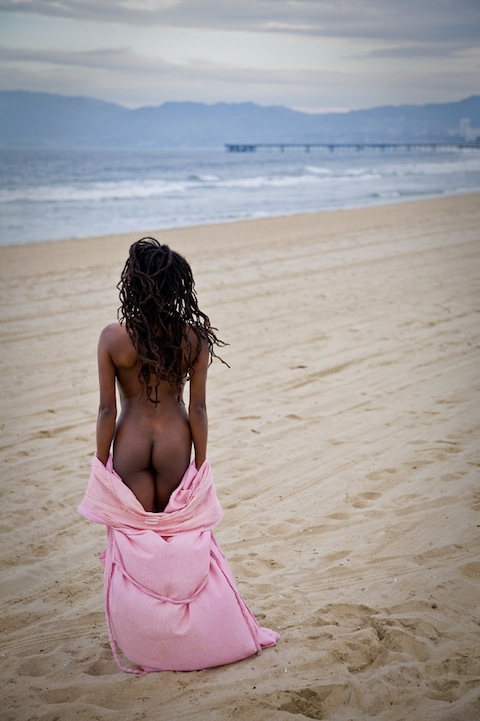
Image by Dan West
|
Susannah: I'll call it self acceptance. Being true to who you are and what you have. Being comfortable with it. With photography modeling, it becomes about the external. With fine art modeling, it doesn't matter what body type you are. Actually, I find, the more awkward your body might look, it is so much more beautiful to paint or to draw, because you get these unique points and ripples and curves and wrinkles, etc. Those are the things I feed on to get a dynamic painting or drawing. Somebody who's just a beautiful coiffed goddess is too smooth. I like what some people may call "abnormalities" or I should say the 'non-commercial' body types. I'm just saying that it doesn't matter what your body type is or how old you are, you can do art modeling, and when you're looking for that internal confidence and you're able to stand in front of a bunch of artists undressed and have them see you as beautiful, it does wonders for your confidence.
Peggy: That really comes through with you. The images you have on your web page are really beautiful.
Susannah: Thank you.
|
|
Michael: So how does a person go about finding modeling opportunities. We initially started this whole conversation around auxiliary income. If you're a starving artist and trying to pay the bills, modeling is one possibility for getting a little pocket money.
Susannah: Oh, yeah. You start up by contacting the art schools. There's always an art department, and usually a model coordinator. You just drop off a pamphlet, or direct them to your online portfolio. You can also get in touch with the artists themselves. Sometimes they will have private sessions for one or several artists at a time, and if you're good, word tends to go around because artists are always looking for different models. They get tired of always drawing the same five models. The more body types, the better for them. Art modeling is good for your home town. A lot of the sittings are spaced over the time span of two-weeks, even a month, so I can't keep flying over to California if I wanted to do an art gig, and it doesn't pay well enough to at least break even. So if you get all of your art modeling in your home town, that pays a lot of bills and then you can take the photography stuff on the road.
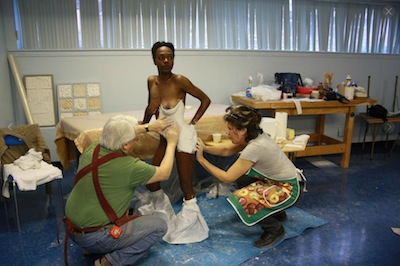
That's pretty much how to market yourself as a model.
Model Mayhem and One Model Place are also good portals. You can also go on Craig's List.
Craig's list has worked for me for New York and San Francisco. Not any of the other cities. I tend to trust Craig's list the most in San Francisco. That's where it was created. You do get some creepy people on there, but I find it easy to tell who is the creepy guy by the way he responds to your email: spelling mistakes, he's incoherent, just the tone. You know, "you've got a really nice ass." Just their words; the way they craft their message. You can pretty much weed out the weird ones from the serious ones. So you can use Craig's list as a backup, but still use your discretion.
Michael: And then there are the online art model web pages too, such as Art Model Place, and there are two or three other ones too.
Susannah: Yeah, besides Model Mayhem, they haven't been that good for me. I am revamping my profiles on Art Model Place,
ARTNudes and Figuremodels.org
and giving it another go, especially with my blog: Diaries of an Art Model. But to get modeling jobs from there, I haven't been successful. Art Model Place is more of the west coast thing rather than the east coast.
Michael: I think that is true.
Susannah: That's where Dave is, down in L.A. He's done an excellent job, but I think he needs to take it to another level. I'm not sure where he wants to go with it. I see incredible potential.
Michael: Southern California does seem to be the hotbed of activity for that site.
Susannah: With Art Nudes, I still haven't figured out how that could be of benefit to me, now that I've moved my blogs over and off my model website. I'm getting more feedback now and it's worth spending a little more time with it.
Michael: How do you mesh all this with relationships with friends and family? Sometimes artists tend to get drilled down into their art and it can be in conflict with other aspects of life.
Susannah: That's a very good question. That has been an ongoing concern for me. Especially when you're dealing in the realm of nudity. There's this perception that if you feel comfortable in the nude then you're a druggie partier, exhibitionist, diva—one of those rock n' roll chicks. So I feel that I'm constantly fighting that stigma of being a rock n' roll party girl who goes around in her 'birthday suit'. They have these unconscious biases, different perceptions that I feel like I'm constantly fighting. For instance, there was something going on about legalizing brothels in Toronto, and I've had some people coming to me and asking what my thoughts were about it, like I had some professional insights about the business of brothels. I haven't got a clue. It has nothing to do with me or what I do! [Laughter]
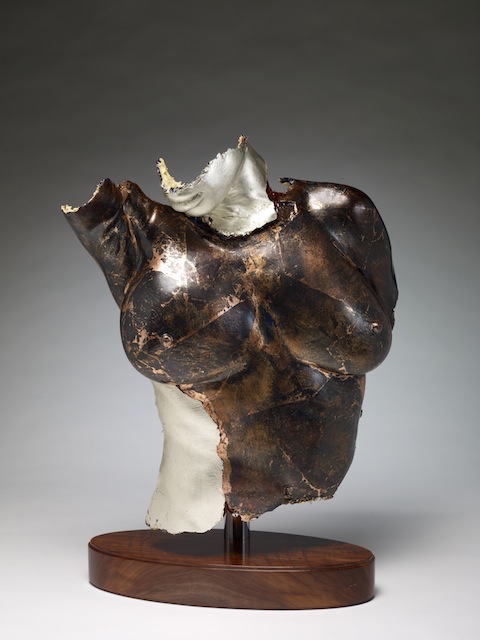
Image by Wayne Berger
And then I do get tunnel focus with my work. No one else is going to do it. You have to create that time for it. And because I'm investing myself in my art work, I have very little funds and time to go around, whether it's to go to a bar for a drink or to treat my friends. You don't have that extra income. People look at you as if you're lazy and you don't want to get a job. I might not have the latest trinkets or gadgets, like a flat screen TV or the latest iPad or iPod—those little things that having a consistent job gives you the income to buy. But the money that one would take to buy those 'whistles and bells'—for me—that money gets reinvested into my art. I'm too busy buying paint brushes or paying for a flight to get to a photo gig, etc. So whatever money I amass that would normally go into showing that I'm a participating citizen—no. It goes into my art. So some people see it as being selfish and self absorbed, but sometimes I could say they're jealous because I have that freedom. I've crafted my life where I can come and go and I'm not bogged down by those things. I don't have any children. I don't know how women do it with kids. But if I ever do become pregnant, I'd still do it. I'd love to pose pregnant.
With my family, the issue really hasn't come up. Because of our Christian upbringing I know not to push the envelope. I've kind of shrugged my shoulders at that. My dad's the fine artist. I'm sure that he's painted art models all the through his training. Of all people, he should know what I'm doing, and that it's not bad at all. My family hasn't really said anything, they've kind of distanced themselves from me. I guess they're just trying to figure out where I'm at.
|
|
When you start in this line of work, you don't know how it's going to come out. It snowballs. It rolls and rolls and rolls. For me it's always been fine art and I've never gone beyond that. I think that's why I get that hesitancy, because I'm walking a line that can easily get blurred.
But with friends, when I first started off, many thought I was being lazy and I didn't want to find a job, or that I'm 'chasing rainbows' or I'm doing this because I want recognition, like as if I'm some power hungry attention seeker. But when you're walking an unconventional path, it does takes a certain effort, and time, and energy. I can't do both. It's like with anything, if you're a student or an entrepreneur starting your own business, you live the same life of 'tunnel vision', supporting your passion while trying to make ends meet. But because it's in the realm of art, and people view art as just fun, generally they think you're a lazy person.
Peggy: "It's just a hobby."
|
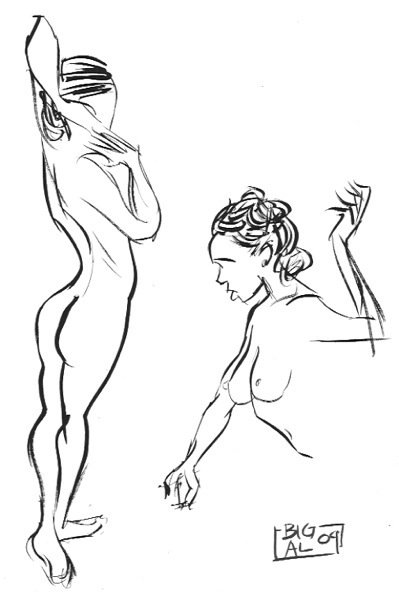
Image by Al Lopez
|
|
Susannah: Yeah, but they say it's a serious hobby for me. Some of them gave up on me and some are still supportive from afar. But the sacrifices I've made, I feel, were worth it because now my art has matured enough that it's not about building, but maintaining. That's what I made that investment for. I'm feel that I'm about to reap the rewards—yet I'm fully aware that whatever those rewards are, it can be an illusion and short-lived because another challenge is always around the corner. There is no getting to the top, because once you think you're there you quickly realize it's just another plateau and you've got more to go. My challenge today is to find the right balance in my relationships and my work. It can get very lonely sometimes and building a strong support network is key. This network doesn't have to be so wide, just a few strong connections. Because what good are the rewards if you have no one to share them with?
Michael: So what's next?
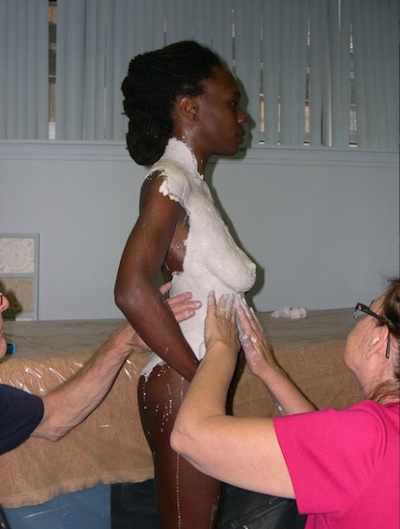
Susannah: Right now I'm trying to focus more on my own work. I got tired of participating as a model in other people's work and not having time for my own work. I'm the artist here, so why not start working on my own art. So as stated before I'm back to working on my sunflower paintings, I got into body casting, and I'm focusing on my writing. While I don't mind participating in other people's work, I still need to feed my artistic side as well. At the end of the day, even though modeling is artistic, the final work belongs to the artist. And when they sell it, they get the money. I don't.
Peggy: And their name is on it.
Susannah: Exactly! The photographer. They get to do anything they want with the image, but models are restricted to portfolio use only. Especially on a TFP shoot. You're not getting paid at all, except for a simple "thank you."
Michael: I think you'll be interested in this thing I told you about with Miru Kim. She is the artist. She often sets up the camera herself and does timer delayed shots, but sometimes she will hire a photographer or have an assistant of some kind, who actually pushes the button. But she sets up the shots, composes the image, and poses for the shots, and it's her work. That's an interesting approach too.
Susannah: I would like to try that approach. Thankfully my brother is a photographer, so maybe he can show me how to do it. I have my own ideas. She's got it right to hire somebody because the copyright is hers. I have a lot of ideas. And a lot of photographers say, "If you have any ideas you'd like to explore, come to the shoot with them." I've often not done it because it's my idea, and in the end it's his images – unless we write it into the model release, which is rare but not impossible. For example, my work with Rich Tosti out in Rhyolite, red rock canyon just beyond Las Vegas, we spent a week out there shooting and he gave me a copy all the raw images we took, which was close to 5,000 images. He gave me a release form allowing me to do whatever I please with the only two instructions, credit and if a third party, such as a poster company, should become interested then he needs to be notified and in on the deal. Which is understandable because that's where big bucks could be made.
Michael: I think that same thing could happen with the body casting. If you had someone applying the mold material, you could do your own art with your own body. That's very interesting.
|
|
Susannah: That's what I'm doing right now.
Michael: Very good!
Susannah: I've body cast every part of my body, and there are places I can't reach, so having another person is very helpful. But the artistic component comes in once the cast is made. What do you do with it? Also, I'm the one thinking of the pose. They're just applying the material. So they become the secondary artist, so to speak.
Michael: I like this.
Susannah: It's really working for me. I hope to have some pieces in a show in November. It's a juried figurative show. We'll see what happens, I'm still not that confident in my works so far. We'll see if my work gets selected, if I submit—hey nothing ventured, nothing gained.
|
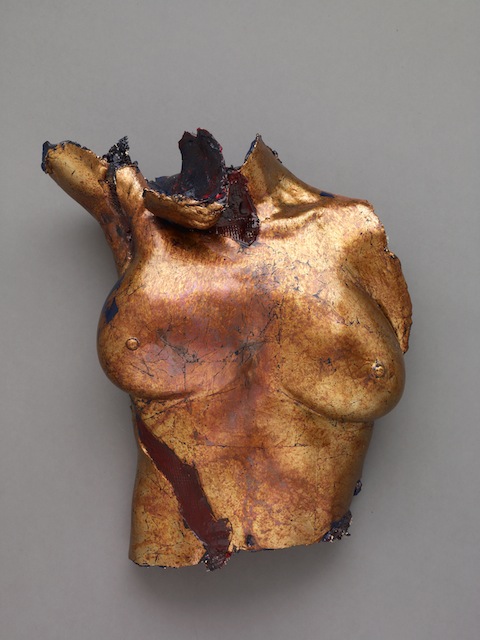
Image by Wayne Berger
|
|
Peggy: Let us know. We'll be following that.
Michael: What advice would you give to someone who is thinking about being an artist, or being a model?
Susannah: I would say to be sure you have some sort of security blanket. Some sort of funds available. You do have to eat at the end of the day. You do need a roof over your head. Figure how far you're willing to go to do without. Are you willing to downsize? You have to be able to downsize your living if it comes to that. It's about compromise. You can't take on all these extra expenses. You have to look at how you're going to support yourself. Pretend that you're the only person there. No mommy and daddy, no sugar daddy/mommy, no boyfriend or girlfriend—it's just you—nobody to help you out. So from there, how much does it take for you to live, and where can you compromise? Once you start weighing those issues, you get to understand if it's something viable for you to do or not.
Peggy: Priorities.
Susannah: Yes. How far are you willing to go.
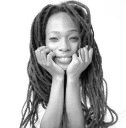
Image by Xposure 101
|
|
























